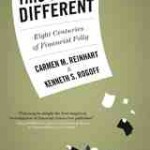 There is an old adage that we learn best from mistakes. A more poignantly popular saying is that if we don’t keep history alive, we are destined to repeat it. All evidence suggests, however, that human beings are slow learners and that we forget the past long before the ink in the history books is dry. We are particularly bad at things like probability, advanced math, and imagining that anything could go wrong since we’ve relied on science and the guarantees of corporate CEOs.
There is an old adage that we learn best from mistakes. A more poignantly popular saying is that if we don’t keep history alive, we are destined to repeat it. All evidence suggests, however, that human beings are slow learners and that we forget the past long before the ink in the history books is dry. We are particularly bad at things like probability, advanced math, and imagining that anything could go wrong since we’ve relied on science and the guarantees of corporate CEOs.
When it comes to predicting financial crises? We’re really bad at that, too.
In the face of the “blinking red lights” of imminent financial chaos, we generally exhibit more wisdom-deficiency, than recognition, that something awful is about go down. In This Time is Different: Eight Centuries of Financial Folly, economists Carmen M. Reinhart and Kenneth S. Rogoff delve deep into the past to explain the predictability of financial crises – including the current one. 800 years of data and sixty-six countries suggest that the signs of impending calamity are eminently recognizable. Instead of disastrous one-offs, they are serial in nature with common patterns in the way they unfold. If we simply recognize the patterns, the overall effects of an economic disaster could be less dire.
We don’t recognize that the runaway train is about to make mincemeat of the economy because human judgment is too often impaired by something the authors call the This Time is Different Syndrome, “[…] rooted in the firmly held belief that financial crises are things that happen to other people at other times. We are doing things better, we are smarter, we have learned from past mistakes.”
In the run-up to the current financial crisis, beginning in the late 2000s, many signs of impending doom were routinely ignored or explained away by experts. Given the number of signs affecting different areas of the economy, it is incredible that they were so easily denied.
[…] the subprime crisis, standard indicators for the United States, such as asset price inflation, rising leverage, large sustained current account deficits, and a slow trajectory of growth, exhibited virtually all the signs of a country on the verge of financial crisis – indeed a severe one.
Imagine hiking the Kaibab and missing the Canyon.
So how did it happen here? Reinhart and Rogoff suggest that we are particularly prone to faulty thinking that results from beliefs like It Will Never Happen Here. “Everything is fine because of globalization, the technology boom, our superior financial system, our better understanding of monetary policy, and the phenomenon of securitized debt.” American views about our unique place in the world and the special qualities of American-ness can be blinders to the possibilities of disaster hitting home. “U.S. conceit” led a lot of people to conclude that a financial crisis, like those that happened elsewhere in the past, wouldn’t happen here; “this time was different” because the United States is “special.”
Readers should not be daunted by pages of detailed analyses and the many tables of data. Reinhart and Rogoff appeal to the financially literate and the not-so-literate alike. The book is organized chronologically with today’s catastrophe a self-contained section at the end. A perfect starting point for those who want to experience the maximum in hindsight. A notable feature is the analysis of common characteristics of a bank crisis aftermath. If the data are correct, we are at least halfway out of the present one. The authors also explain the inevitability of things like increasing unemployment and government debt to be expected in any aftermath. Spoiler Alert: it’s not Obama’s fault.
Are we destined to repeat the past? Side-stepping future financial crises isn’t likely to happen – indeed we shouldn’t expect that we can. But recognizing the signs before the next big one? It couldn’t hurt.







